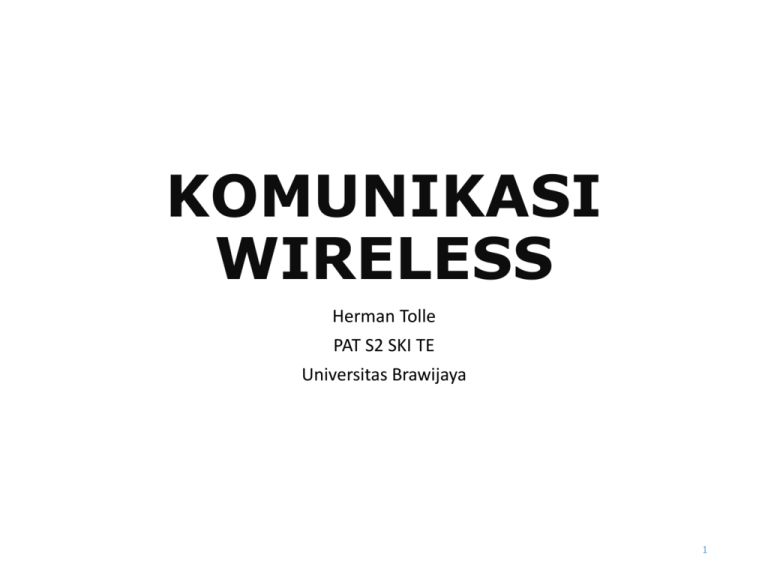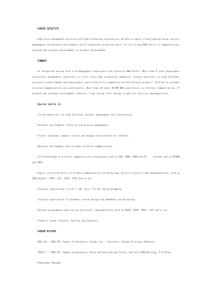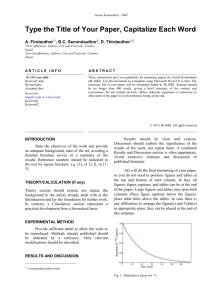07-TIK-Komunikasi
advertisement

KOMUNIKASI WIRELESS Herman Tolle PAT S2 SKI TE Universitas Brawijaya 1 Outline Komunikasi Wireless / Nirkabel Pemanfaatan Komunikasi Nirkabel Tipe Komunikasi Nirkabel Standard Komunikasi Nirkabel Evolusi Komunikasi Nirkabel Kontent & Aplikasi Spektrum Frekuensi Frekuensi Carrier / Kanal Mode Komunikasi Prinsip kerja GPS 2 Komunikasi Nirkabel Sistem Komunikasi menggunakan gelombang elektromagnetik, frekuensi/ spektrum radio, yang memungkinkan transmisi (pengiriman/ penerimaan) informasi (suara, data, gambar, video) tanpa koneksi fisik Muncul sebagai jawaban atas keterbatasan jaringan wireline. Mobilitas manusia yang tinggi dan informasi yang selalu dekat menjadi faktor pendorong utama berkembangnya teknogi ini. Bersifat tetap (fixed) atau bergerak (mobile) 3 Wireless technology Wireless telecommunications refers to the transfer of information between two or more points that are not physically connected. Distances can be short, such as a few meters for television remote control, or as far as thousands or even millions of kilometers for deep-space radio communications. It encompasses various types of fixed, mobile, and portable applications, including two-way radios, cellular telephones, personal digital assistants (PDAs), and wireless networking. Other examples of wireless technology include GPS units, garage door openers, wireless computer mice, keyboards and headsets, headphones, radio receivers, satellite television, broadcast television and cordless telephones. Komunikasi Nirkabel 5 Komunikasi Nirkabel Komunikasi menggunakan gelombang elektromagnetik Gelombang elektromagnetik • • • • Kecepatan cahaya (c = 3x108 m/s) Memiliki frekuensi (f) dan panjang gelombang (l) c=fxl Penggunaan frekuensi lebih tinggi umumnya medium meredam lebih besar 7 Klasifikasi Komunikasi Nirkabel Non Cellular Fixed Wireless contoh : point to point communication, infra red communication, LMDS, Microwave communication contoh : Cellular Wireless Communication Non Cellular Mobile Wireless PHS, CT2, PACS, DCS1800, DECT contoh : paging system (ERMES, NTT, NEC) , dispatching system, PAMR (Public Access Mobile Radio) dsb contoh : Cellular GSM, CDMA/IS-95, AMPS, UMTS, PHS, DCS1800, NMT450, TACS, C-450, CDMA 2000 dsb 8 How is the information transferred? Wireless operations permits services, such as long range communications, that are impossible or impractical to implement with the use of wires. Telecommunications systems: • • • • radio transmitters and receivers, remote controls, computer networks, network terminals, etc. They use some form of energy • • • • • • Radio frequency (RF), Infrared light, Microwave communication, Laser light, Visible light, Acoustic energy, etc. to transfer information without the use of wires. Microwave communication => Radio Frequency communication => Infrared communication => Penggunaan Wireless network: • To span a distance beyond the capabilities of typical cabling, • To provide a backup communications link in case of normal network failure, • To link portable or temporary workstations, • To overcome situations where normal cabling is difficult or financially impractical, • to remotely connect mobile users or networks. • to connect laptop users who travel from location to location. • for mobile networks that connect via satellite. • to network a LAN segment that must frequently change locations • Wireless technology may supplement or replace hard wired implementations in security systems for homes or office buildings. Pemanfaatan Teknologi Nirkabel Layanan Bersifat tetap (fixed): Penggunaan sekitar rumah (Cordless-DECT) Sambungan lokal (wireless local loop-WLL) Bluetooth: jarak pendek, kecepatan rendah WiFi: jarank menengah, kecepatan cukup tinggi WIMAX: jarak jauh, kecepatan tinggi Satellite: jangkauan luas, kecepatan menengah RFID: jangkauan sangat kecil Layanan Bersifat bergerak (mobile): Limited Mobility (Flexi) Cellular (GSM, CDMA, 3G, 4G) Satellite (GMPCS) 12 Types of Wireless Communications: point-to-point communication: from one location to the other point-to-multipoint communication: from a single location to multiple locations Broadcasting: from one location to all locations simultaneously Cellular networks: this networks allows the user to wander about any where in the country and stay connected other wireless networks. Broadcasting Antenna MEDIA KOMUNIKASI NIRKABEL RADIO TRANSMISSION:- easily generated, Omni-directional , travel long distance , easily penetrates buildings. • PROBLEMS:- frequency dependent , relatively low bandwidth for data communication , tightly licensed by government. MICROWAVE TRANSMISSION:- widely used for long distance communication , relatively inexpensive. • PROBLEMS:- don’t pass through buildings , weather and frequency dependent. MEDIA KOMUNIKASI NIRKABEL INFRARED AND MILIMETER WAVES:Widely used for short range communication , unable to pass through solid objects , used for indoor wireless LANs , not for outdoors. LIGHT WAVE TRANSMISSION:- unguided optical signal such as laser , unidirectional , easy to install , no license required. PROBLEMS:- unable to penetrate rain or thick fog , laser beam can be easily diverted by air. Jenis Teknologi Nirkabel Degree of mobility Driving UMTS CDMA Systems beyond 3G >2010 GSM GPRS Standing Walking UMTS HSDPA EDGE EV-DO EV-DV IEEE 802.16e FlashOFDM (802.20) DECT WLAN (IEEE 802.11x) BlueTooth 0.1 1 10 IEEE 802.16a,d 100 Mbps User data rate 17 Standard Nirkabel IEEE 802.21, IEEE 802.18 802.19 IEEE 802.15.4 (Zigbee Alliance) Sensors (BAN) IEEE 802.22 RAN WAN IEEE 802.20 IEEE 802.16e IEEE 802.16d WiMAX IEEE 802.11 Wi-Fi Alliance IEEE 802.15.3 UWB, Bluetooth Wi-Media, BTSIG, MBOA MAN LAN PAN RFID (AutoID Center) BAN: Body Area Network 3GPP (GPRS/UMTS) 3GPP2 (1X--/CDMA2000) GSMA, OMA ETSI HiperMAN & HIPERACCESS ETSI-BRAN HiperLAN2 ETSI HiperPAN 18 System Evolution Scenario st Generation 1 Generation (Cellular) Analog voice 2nd Generation Digital voice & Low rate data 3rd Generation 4th Generation Voice & High speed ALL-IP Broadband Ubiquitous & Seamless data Multimedia WLAN++ 1000 ) Maximum transmission rate TRmax Mbps ( WLAN+ 802.11n, etc. WiMAX 100 WLAN 802.11a,HiSWANa, UWB, etc. HIPERLAN2, etc. 3G+ Nomadic HSDPA, 10 4G cdma2000(3X), etc. 3G Bluetooth, etc. W-CDMA, 1 Local 0.1 Mobile 0.01 Cdma2000, etc. 2G+ PDC,GSM,PHS, etc. 2G PDC,GSM,PHS, etc. ~1990 1995 2000 2005 2010 2015 Year 19 GSM Evolution GSM CS Up to 9,6 Kbps 2G GSM GPRS Up to 115 kbps GSM HSCSD Up to 38,4 kbps UMTS Up to 2 Mbps or 384 in mobility 3G 2.5G EDGE Operators prefer choose direct going to GPRS technology rather than going to GSM HSCSD technology because no HSCSD handset availability and short time stage 20 CDMA Standards Evolution IS-95A CDMA Voice, packet9.6/14.4 Kbps IS-95B CDMA Voice, packet64 Kbps IS-2000 1X 144 Kbps 600 Kbps peak IS-2000 1XEV-DO 600 Kbps; 2.4 Kbps peak IS-2000 1XEV-DV 2-5 Mbps peak All IP Source: CDMA2000-A world view 21 IMT-2000 (Family of Standards) IMT-2000 Terrestrial Radio Interfaces IMT-2000 CDMA Direct Spread WCDMA (UMTS) IMT-2000 CDMA Multi Carrier CDMA2000 1X and 3X CDMA IMT-2000 CDMA TDD IMT-2000 TDMA Single Carrier UTRA TDD And TD-SCDMA TDMA UWC-136/ EDGE IMT-2000 FDMA/ TDMA DECT FDMA 22 Content & Aplikasi 23 Spektrum frekuensi 104 102 100 10-2 Radio Spectrum 104 106 108 10-4 Micro wave 1010 1MHz ==100m 100MHz ==1m 10GHz ==1cm Alokasi Frekeunsi ! 1012 10-6 IR 10-8 UV 1014 1016 Visible light 10-10 10-12 10-14 10-16 X-Rays 1018 1020 Cosmic Rays 1022 < 30 KHz 30-300KHz 300KHz – 3MHz 3 MHz – 30MHz 30MHz – 300MHz 300 MHz – 3GHz 3-30GHz > 30 GHz 1024 VLF LF MF HF VHF UHF SHF EHF 24 Frequency • FM RADIO • TV BROADCAST • GSM PHONES • GPS • PCS PHONES • BLUETOOTH • Wi-Fi 88 MHZ 200 MHZ 900 MHZ 1.2 GHZ 1.8 GHZ 2.4 GHZ 2.4 GHZ Contoh: Panjang gelombang GSM : Frekuensi ~= 900 Mhz Panjang gelombang ~= 33cm PCS Frekuensi ~= 1.8 Ghz Panjang gelombang ~= 17.5 cm Bluetooth: Frekuensi ~= 2.4Gz Panjang gelombang ~= 12.5cm 26 Frequency Carrier/Kanal • Informasi yang dikirim menuju receiver dilewatkan pada band frekuensi tertentu. • Disebut sebagai kanal (channel) • Tiap kanal memiliki bandwidth yang tetap (dalam KHz) dan kapasitas (bitrate) • Band frekuensi yang berbeda (atau kanal) dapat digunakan untuk mentransmisikan informasi secara paralel dan independen (konsep multiple access). 27 Example • Assume a spectrum of 90KHz is allocated over a base frequency b for communication between stations A and B • Assume each channel occupies 30KHz. • There are 3 channels • Each channel is simplex (Transmission occurs in one way) • For full duplex communication: • Use two different channels (front and reverse channels) • Use time division in a channel Station A Channel 1 (b - b+30) Channel 2 (b+30 - b+60) Channel 3 (b+60 - b+90) Station B 28 Simplex Communication • Normally, on a channel, a station can transmit only in one way. • This is called simplex transmision • To enable two-way communication (called full-duplex communication) • We can use Frequency Division Multiplexing • We can use Time Division Multiplexing 29 Duplex Communication - FDD • FDD: Frequency Division Duplex Mobile Terminal M Forward Channel Reverse Channel Base Station B Forward Channel and Reverse Channel use different frequency bands 30 Duplex Communication - TDD • TDD: Time Division Duplex Mobile Terminal M M B M B M B Base Station B A singe frequency channel is used. The channel is divided into time slots. Mobile station and base station transmits on the time slots alternately. 31 Example - Frequency Spectrum Allocation in U.S. Cellular Radio Service Reverse Channel 991 992 … 1023 1 Forward Channel … 2 799 824-849 MHz 991 992 … 1023 1 2 … 799 869-894 MHz Channel Number Reverse Channel 1 <=N <= 799 991 <= N <= 1023 Center Frequency (MHz) 0.030N + 825.0 0.030(N-1023) + 825.0 Forward Channel 1 <=N <= 799 0.030N + 870.0 991 <= N <= 1023 0.030(N-1023) + 870.0 (Channels 800-990 are unused) Channel bandwidth is 45 MHz 32 What is Mobility • Initially Internet and Telephone Networks is designed assuming the user terminals are static • No change of location during a call/connection • A user terminals accesses the network always from a fixed location • Mobility and portability • Portability means changing point of attachment to the network offline • Mobility means changing point of attachment to the network online 33 Degrees of Mobility • Walking Users • Low speed • Small roaming area • Usually uses high-bandwith/low-latency access • Vehicles • • • • High speeds Large roaming area Usually uses low-bandwidth/high-latency access Uses sophisticated terminal equipment (cell phones) 34 The Need for Wireless/Mobile Networking • Demand for Ubiquitous Computing • Anywhere, anytime computing and communication • You don’t have to go to the lab to check your email • Pushing the computers more into background • Focus on the task and life, not on the computer • Use computers seamlessly to help you and to make your life more easier. • Computers should be location aware • Adapt to the current location, discover services 35 Advanced 3g and 4g in wireless mobile communication 3g 4G 3G AND 4G MOBILE PHONES 3G 4G GLOBAL POSITIONING SYSTEM (GPS) 40 GLOBAL POSITIONING SYSTEM (GPS) Sistem navigasi yang menggunakan satelit yang berorbit pada Bumi. Satelit GPS memberikan informasi lokasi dan waktu mana saja yang ada di planet Bumi ini selama peranti GPS yang memerlukan informasi ini dapat "melihat" lebih dari tiga satelit GPS di saat yang bersamaan. Satelit-satelit GPS dikelola oleh pemerintah Amerika Serikat dan pertama kali dioperasikan secara penuh oleh departemen pertahanan Amerika Serikat. Aplikasi yang menggunakan peta dapat memanfaatkan informasi dari satelit GPS untuk menentukan lokasi pengguna pada petanya GPS Location Estimation • GPS receiver compares the time when the signal was sent by the satellite with the time the signal was received. • From this time difference the distance between receiver and satellite can be calculated.






